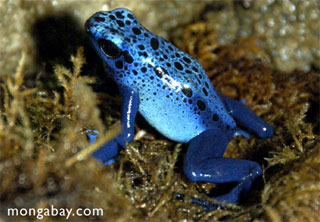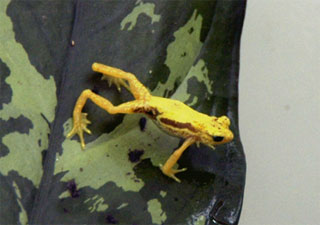Climate change is killing frogs finds new research
Rhett A. Butler, mongabay.com
January 11, 2006
 Panama golden frog |
The dramatic global decline of amphibians may be directly connected to global warming warns a new study published in the journal Nature.
Looking at a group of frogs found in biodiversity hotspots in Central and South America, scientists found links between higher temperatures and frog extinctions caused by a skin fungus. The infectious skin disease—a type of chytrid fungus (Batrachochytrium dendrobatidis)—is now found in frog populations around the world and is the main suspect in the rapid disappearance of amphibians.
Last year, the Global Amphibian Assessment, a survey of the planet’s amphibian species, found that nearly a third (32%) of the world’s 5743 known amphibian species are threatened and 129 species have gone extinct since 1980. Among the species to disappear is Costa Rica’s Golden toad (Bufo periglenes) and the Gastric Brooding Frog (Rheobatrachus silus) of Queensland, Australia. Scientists believe there may be around 10,000 amphibian species on the planet, although this number is likely to be falling fast.
In linking climate change with frog extinction, the international team, led by J. Alan Pounds of the Tropical Science Center’s Monteverde Cloud Forest Preserve in Costa Rica, focused on the brightly colored harlequin frogs (Atelopus) which are critically endangered across their range—between the 1980s and 1990s, almost two-thirds of the 110 known harlequin frog species went extinct with the chytrid fungus the leading suspect.
Using records of sea-surface and air temperatures, the researchers discovered strong correlations between changes in climate and the last known sightings of the frogs. According to the scientists, the Earth’s rising temperatures enhance cloud cover on tropical mountains, leading to cooler days and warmer nights, both of which favor the chytrid fungus which grows and reproduces best at temperatures between 63 to 77 degrees Fahrenheit (17 to 25 degrees Celsius).
The fungus kills frogs mostly in cool highlands or during winter, implying that low temperatures make it more deadly. Thus the disease flourishes in warm years and puts frogs living at mid-altitudes at greatest risk.
In coming years, further changes in climate change will likely produce conditions more favorable for the fungus and detrimental to frogs and other amphibians.
“Disease is the bullet that’s killing the frogs,” said J. Alan Pounds. “But climate change is pulling the trigger. Global warming is wreaking havoc on amphibians, and soon will cause staggering losses of biodiversity,” he said.
“The good news, if there is any, is the new findings will open up avenues of research that could provide scientists with the means to save the amphibians that still survive,” said Bruce Young, a zoologist at NatureServe who took part in the study. “If this cloud has any silver lining, that’s it.”
The new theory for the frogs’ decline “leaps over a major roadblock in our understanding,” said Sam Scheiner, program director for the National Science Foundation (NSF)’s ecology of infectious diseases program, which funded the research. “This study demonstrates the complex nature of global climate change, including how climate affects the spread of disease, and why these must be integrated if we are to understand and reduce threats to species extinctions.”
 Poison arrow frog |
Ecologists fear that the global decline of amphibians may have broader implications for the world’s environment. Because amphibians have highly permeable skin and spend a portion of their life in water and on land, they are sensitive to environmental change and can act as the proverbial “canary in a coal mine,” indicating the relative health of an ecosystem. As they die, scientists are left wondering what plant or animal group is next.
Scheiner says global warming and the accompanying emergence of infectious diseases are a real and immediate threat to biodiversity and a growing challenge for humankind.
The disappearance of amphibians is troubling on other grounds as well. Many frogs and toads secrete toxic alkaloids to protect themselves from predators. These alkaloids have been found to have medical applications as pain killers. Thus the loss of each amphibian species eliminates the possibility of finding compounds with potential curative properties.
 Kihansi Spray Toad |
In September a group of conservation scientists proposed a $404 million effort to preserve declining global amphibian populations. The strategy calls for funding from governments, private institutions and individual donors to finance long-term research, protect critical habitats, reduce the trade in amphibians for food and pets, and establish captive breeding programs. So far such programs have had mixed success. The Kihansi Spray Toad, a small toad that is virtually extinct in the wild after its habitat was destroyed by a hydroelectric project in Tanzania, only exists today thanks to efforts by the Bronx Zoo of New York, the Detroit Zoo in Michigan, and the Toledo Zoo in Ohio. Nevertheless, the toad’s captive population has fluctuated dramatically in the past few years due to its biology (they breed in groups) and small size, and difficulties typically associated with captive amphibians.
Related articles
794 species on brink of extinction find study
Protecting 595 sites around the world would help address an imminent global extinction crisis, according to a study published today in the Proceedings of the National Academy of Sciences. Conducted by scientists working with the 52 member organizations of the Alliance for Zero Extinction (AZE), the study identifies 794 species threatened with imminent extinction by virtual of existing at only a single remaining site on Earth. The study found that just one-third of the sites are known to have legal protection, and most are surrounded by human population densities that are approximately three times the global average. Safeguarding these sites is key to saving these species from extinction say the authors of the study.
Toad on brink of extinction, scientists race to study amphibian for bioactive compounds
Under the bright florescent lights of the reptile house in the Bronx Zoo of New York, a colorful exotic toad makes its final stand. Once gathering by the thousands at the waterfalls of the Kihansi Gorge of Tanzania, the population of the Kihansi Spray Toad now stands at less than 200 individuals. The hasty construction of a desperately needed dam, built with good intentions by the World Bank, has relegated this species to the edge of existence. A decade ago the Kihansi Spray Toad thrived in its thoroughly unique habitat, the waterfalls of the Kihansi River, part of ecosystem that is one of only 25 Global Biodiversity Hotspots on the planet (Hotspots are regions noted for their extensive range of species in a very small area). The gorge is located in the Southern Udzungwa Mountains of South Central Tanzania, which possess the greatest biodiversity in all of Tanzania.
16% of frogs species in Sri Lanka may be gone, new survey finds
In a study published Thursday in Raffles Bulletin of Zoology, researchers confirmed the discovery of 35 new frog species in Sri Lanka over the past decade brining the number of frog species in the island country to 105. However, the survey found that 17 of these species have disappeared and at least another 11 face imminent extinction unless their habitat is protected.
This article used information from a new release by the National Science Foundation